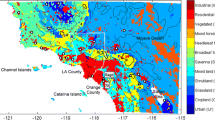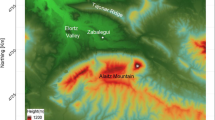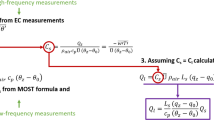Abstract
Inverse methods are widely used in various fields of atmospheric science. However, such methods are not commonly used within the boundary-layer community, where robust observations of surface fluxes are a particular concern. We present a new technique for deriving surface sensible heat fluxes from boundary-layer turbulence observations using an inverse method. Doppler lidar observations of vertical velocity variance are combined with two well-known mixed-layer scaling forward models for a convective boundary layer (CBL). The inverse method is validated using large-eddy simulations of a CBL with increasing wind speed. The majority of the estimated heat fluxes agree within error with the proscribed heat flux, across all wind speeds tested. The method is then applied to Doppler lidar data from the Chilbolton Observatory, UK. Heat fluxes are compared with those from a mast-mounted sonic anemometer. Errors in estimated heat fluxes are on average 18 %, an improvement on previous techniques. However, a significant negative bias is observed (on average \(-63\,\%\)) that is more pronounced in the morning. Results are improved for the fully-developed CBL later in the day, which suggests that the bias is largely related to the choice of forward model, which is kept deliberately simple for this study. Overall, the inverse method provided reasonable flux estimates for the simple case of a CBL. Results shown here demonstrate that this method has promise in utilizing ground-based remote sensing to derive surface fluxes. Extension of the method is relatively straight-forward, and could include more complex forward models, or other measurements.








Similar content being viewed by others
References
Angevine WM, Doviak RJ, Sorbjan Z (1994) Remote sensing of vertical velocity variance and surface heat flux in a convective boundary layer. J Appl Meteorol 33:977–983
Bannister R (2003) The method of least squares to invert an orbit problem. Am J Phys 71:1268–1275
Barlow JF, Dunbar TM, Neimitz EG, Wood CR, Gallagher MW, Davies F, O’Connor E, Harrison RM (2011) Boundary layer dynamics over London, UK as observed using Doppler lidar during Repartee-II. Atmos Chem Phys 11:2111–2125
Beare RJ (2008) The role of shear in the morning transition boundary layer. Boundary-Layer Meteorol 129:395–410
Bouniol D, Illingworth A, Hogan R (2004) Deriving turbulent kinetic energy dissipation rate within clouds using ground based radar. In: Proceedings of ERAD, pp 281–285
Chai T, Lin CL (2004) Retrieval of microscale flow structures from high-resolution Doppler lidar data using an adjoint model. J Atmos Sci 61:1500–1520
Cleugh HA, Grimmond CSB (2001) Modelling regional scale surface energy exchanges and CBL growth in a heterogeneous, urban–rural landscape. Boundary-Layer Meteorol 98:1–31
Davis JC, Collier CG, Davies F, Bozier KE (2008) Spatial variations of sensible heat flux over an urban area measured using Doppler lidar. Meteorol Appl 15:367–380
Deardorff JW (1970) Convective velocity and temperature scales for the unstable planetary boundary layer and for Rayleigh convection. J Atmos Sci 27:1211–1213
Drennan WD, Zhang JA, French JR, McCormick C, Black PG (2007) Turbulent fluxes in the hurricane boundary layer. Part II: latent heat flux. J Atmos Sci 64:1103–1115
Engelbart DAM, Kallistratova M, Kouznetsov R (2007) Determination of the turbulent fluxes of heat and momentum in the ABL by ground-based remote-sensing techniques (a review). Meteorol Z 16:326–335
Gal-Chen T, Xu M (1992) Estimations of atmospheric boundary-layer fluxes and other turbulence parameters from Doppler lidar data. J Geophys Res 97:409–423
Hogan R (2007) A variational scheme for retrieving rainfall rate and hail reflectivity fraction from polarization radar. J Appl Meteorol 46:1544–1564
Hogan RJ, Grant ALM, Illingworth AJ, Pearson GN, O’Connor EJ (2008) Vertical velocity variance and skewness in clear and cloud-topped boundary layers as revealed by Doppler lidar. Q J R Meteorol Soc 135:635–643
Kaimal JC, Wyngaard JC, Haugen DA, Cote OR, Izumi Y, Caughey SJ, Readings CJ (1976) Turbulence structure in the convective boundary layer. J Atmos Sci 33:2152–2169
Lenschow DH, Wulfmeyer V (2000) Measuring second through fourth order moments in noisy data. J Atmos Ocean Technol 17:1330–1347
Lenschow DH, Wyngaard JC, Pennell WT (1980) Mean-field and second-moment budgets in a Baroclinic, convective boundary layer. J Atmos Sci 37:1313–1326
Lenschow DH, Mann J, Kristensen L (1994) How long is long enough when measuring fluxes and other turbulence statistics? J Atmos Ocean Technol 11:661–673
Lenschow DH, Lothon M, Mayor SD, Sullivan PP, Canut G (2012) A comparison of higher-order vertical velocity moments in the convective boundary layer from lidar with in situ measurements and LES. Boundary-Layer Meteorol 143:107–123
Lorenc AC (1986) Analysis methods for numerical weather prediction. Q J R Meteorol Soc 112:1177–1194
Newsom RK, Banta RM (2004) Assimilating coherent Doppler lidar measurements into a model of the atmospheric boundary layer. Part I: algorithm development and sensitivity to measurement error. J Atmos Ocean Technol 21:1328–1345
O’Connor EJ, Illingworth AJ, Brooks IM, Westbrook CD, Hogan RJ, Davies F, Brooks BJ (2010) A method for estimating the turbulent kinetic energy dissipation rate from a vertically-pointing Doppler lidar and independent evaluation from balloon-borne in-situ measurements. J Atmos Ocean Technol 27:1652–1664
Pearson G, Davies F, Collier C (2009) An analysis of the UFAM pulsed Doppler lidar for observing the boundary layer. J Atmos Ocean Technol 26:240–250
Rodgers CD (2000) Inverse methods for atmospheric sounding. World Scientific Publishing, London, pp i–xvi
Roth M (2000) Review of atmospheric turbulence over cities. Q J R Meteorol Soc 26:941–990
Rudd AC, Robins AG, Lepley JJ, Belcher SE (2011) An inverse method for determining source characteristics for emergency response applications. Boundary-Layer Meteorol 144:1–20
Rye BJ, Hardesty RM (1993) Discrete spectral peak estimation in incoherent backscatter heterodyne lidar. II: correlogram accumulation. IEEE Trans Geosci Remote Sens 31:28–35
Shutts GJ, Gray MEB (1994) A numerical modelling study of the geostrophic adjustment process following deep convection. Q J R Meteorol Soc 120:1145–1178
Sorbjan Z (1988) Local similarity in the convective boundary layer. Boundary-Layer Meteorol 45:237–250
Sorbjan Z (1990) Similarity scales and universal profiles of statistical moments in the convective boundary layer. J Appl Meteorol 29:762–775
Sorbjan Z (1991) Evaluation of local similarity functions in the convective boundary layer. J Appl Meteorol 30:1565–1583
Sullivan PP, Patton EG (2011) The effect of mesh resolution on convective boundary layer statistics and structures generated by large-eddy simulation. J Atmos Sci 68:8995–9005
Willmott CJ, Ackleson SG, Davis RE, Feddema JJ, Klink KM, Legates DR, O’Donnell J, Rowe CM (1985) Statistics for the evaluation and comparison of models. J Geophys Res 90:2395–2415
Young GS (1988) Turbulence structure of the convective boundary layer. Part I: variability of normalized turbulence statistics. J Atmos Sci 45:719–726
Acknowledgments
The authors wish to thank Alan Grant for running the LEM to provide CBL simulations, and guidance in interpretation of the results. T. Dunbar was funded through a Natural Environment Research Council Grant Reference Number NE/F00706X/1.
Author information
Authors and Affiliations
Corresponding author
Rights and permissions
About this article
Cite this article
Dunbar, T.M., Barlow, J.F. & Belcher, S.E. An Optimal Inverse Method Using Doppler Lidar Measurements to Estimate the Surface Sensible Heat Flux. Boundary-Layer Meteorol 150, 49–67 (2014). https://doi.org/10.1007/s10546-013-9858-2
Received:
Accepted:
Published:
Issue Date:
DOI: https://doi.org/10.1007/s10546-013-9858-2




